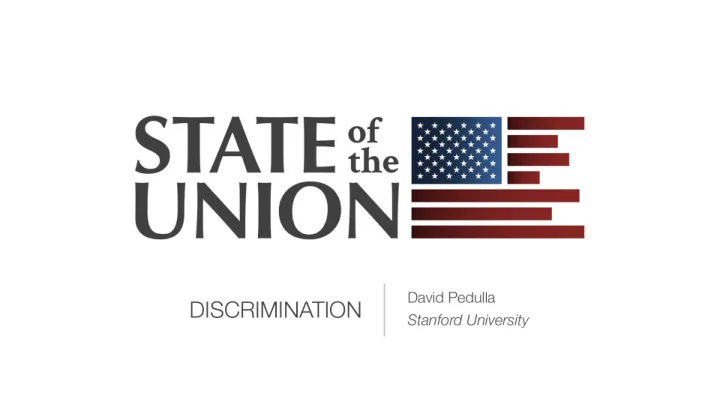

David S. Pedulla Stanford University dpedulla@stanford.edu State of the Union, 2018 Stanford Center on Poverty & Inequality
▪ Gender discrimination occurs across institutional domains, from education, to health care, to consumer markets, and beyond. ▪ Focus today on gender discrimination in employment. ▪ Specifically, I will discuss gender discrimination in hiring.
▪ Gender Discrimination: ▪ Differential treatment of a person (or group) due to their gender. ▪ Focus on behaviors, rather than attitudes, beliefs, or ideologies. ▪ Gender Discrimination Example: ▪ A woman has equal (or superior) skills, educational credentials, and ability compared to a man. ▪ They both apply for the same job. ▪ The man gets hired.
1. Discrimination is difficult to observe. 2. Discrimination is difficult to detect.
▪ Send matched pairs of nearly identical fictitious job applications to apply for real job openings. ▪ Randomly assign resumes a gender, often using gendered names (e.g., Michelle vs. Michael). ▪ Track employers’ responses to each application (e.g., “callbacks”). ▪ Because everything is held constant, other than the gendered name, any difference in “callback” rates can be attributed to gender discrimination. ▪ Solves the dual challenges of observation and detection.
8.0% 6.6% 7.0% 6.0% 5.0% Callback Rate 5.0% 4.0% 3.1% 2.8% 3.0% 2.0% 1.0% 0.0% Men Women Non-Parent Parent Correll, Shelley J., Stephen Benard, and In Paik. 2007. “Getting a Job: Is There a Motherhood Penalty?” American Journal of Sociology 112(5):1297-1339.
8.0% 6.6% 7.0% 6.0% 5.0% Callback Rate 5.0% 4.0% 3.1% 2.8% 3.0% 2.0% 1.0% 0.0% Men Women Non-Parent Parent Correll, Shelley J., Stephen Benard, and In Paik. 2007. “Getting a Job: Is There a Motherhood Penalty?” American Journal of Sociology 112(5):1297-1339.
8.0% 6.6% 7.0% 6.0% 5.0% Callback Rate 5.0% 4.0% 3.1% 2.8% 3.0% 2.0% 1.0% 0.0% Men Women Non-Parent Parent Correll, Shelley J., Stephen Benard, and In Paik. 2007. “Getting a Job: Is There a Motherhood Penalty?” American Journal of Sociology 112(5):1297-1339.
16.3% 16.0% 14.0% 12.0% Callback Rate 10.0% 8.0% 6.3% 6.0% 3.8% 4.0% 1.3% 2.0% 0.0% Men Women Higher-Class Lower-Class Rivera, Lauren A., and András Tilcsik. 2016. “Class Advantage, Commitment Penalty: The Gendered Effect of Social Class Signals in an Elite Labor Market.” American Sociological Review 81(6):1097-1131.
16.3% 16.0% 14.0% 12.0% Callback Rate 10.0% 8.0% 6.3% 6.0% 3.8% 4.0% 1.3% 2.0% 0.0% Men Women Higher-Class Lower-Class Rivera, Lauren A., and András Tilcsik. 2016. “Class Advantage, Commitment Penalty: The Gendered Effect of Social Class Signals in an Elite Labor Market.” American Sociological Review 81(6):1097-1131.
16.3% 16.0% 14.0% 12.0% Callback Rate 10.0% 8.0% 6.3% 6.0% 3.8% 4.0% 1.3% 2.0% 0.0% Men Women Higher-Class Lower-Class Rivera, Lauren A., and András Tilcsik. 2016. “Class Advantage, Commitment Penalty: The Gendered Effect of Social Class Signals in an Elite Labor Market.” American Sociological Review 81(6):1097-1131.
14.0% 12.0% 10.9% 10.4% 10.4% 10.0% Callback Rate 7.5% 8.0% 6.0% 4.8% 4.2% 4.0% 2.0% 0.0% Men Women Full-Time Work Part-Time Work Unemployment Pedulla, David S. 2016. “Penalized or Protected? Gender and the Consequences of Nonstandard and Mismatched Employment Histories.” American Sociological Review 81(2):262-289.
14.0% 12.0% 10.9% 10.4% 10.4% 10.0% Callback Rate 7.5% 8.0% 6.0% 4.8% 4.2% 4.0% 2.0% 0.0% Men Women Full-Time Work Part-Time Work Unemployment Pedulla, David S. 2016. “Penalized or Protected? Gender and the Consequences of Nonstandard and Mismatched Employment Histories.” American Sociological Review 81(2):262-289.
14.0% 12.0% 10.9% 10.4% 10.4% 10.0% Callback Rate 7.5% 8.0% 6.0% 4.8% 4.2% 4.0% 2.0% 0.0% Men Women Full-Time Work Part-Time Work Unemployment Pedulla, David S. 2016. “Penalized or Protected? Gender and the Consequences of Nonstandard and Mismatched Employment Histories.” American Sociological Review 81(2):262-289.
▪ Contextual Forces & Gender Discrimination: ▪ Status of job (e.g., professional vs. working class). ▪ Gender composition of job. ▪ Gender-typing of job. ▪ Field Experiment Findings (Yavorksy 2017): ▪ Women experience discrimination when applying for male-dominated working class jobs. ▪ Men experience discrimination when applying for female-dominated jobs, across the status of the position. Yavorsky, Jill. 2017. Inequality in Hiring: Gendered and Classed Discrimination in the Labor Market . Doctoral Dissertation. Columbus, Ohio: The Ohio State University.
▪ The effects of gender on hiring discrimination are complex and heterogeneous: ▪ Parental status ▪ Class background ▪ Employment history ▪ Contextual forces ▪ Commitment concerns are a key mechanism linking gender and hiring outcomes. ▪ Violations of gender norms also appear to be important in producing gender discrimination.
▪ Continued and additional attention to mechanisms: ▪ Commitment ▪ Competence ▪ Fit ▪ Continued and additional attention to variation: ▪ Policy and legal environments ▪ Organizational demography ▪ Organizational policies ▪ Organizational practices ▪ Developing and testing interventions to reduce gender discrimination.
David S. Pedulla Stanford University dpedulla@stanford.edu
Recommend
More recommend